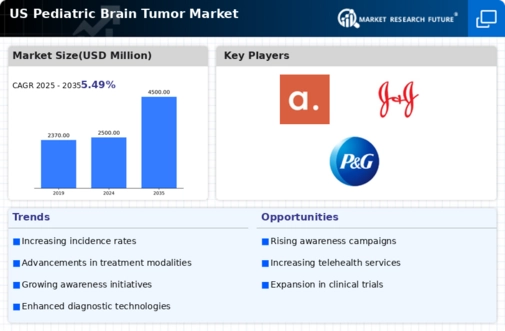Growing Awareness and Support Networks
Growing awareness and support networks for affected families positively impact the pediatric brain-tumor market. Advocacy groups and non-profit organizations are actively working to raise awareness about pediatric brain tumors, leading to increased funding and research initiatives. These organizations provide essential resources and support for families navigating the complexities of treatment. As awareness grows, more families are likely to seek specialized care, which could drive demand for innovative therapies and treatment options. The establishment of support networks also fosters collaboration among healthcare providers, researchers, and families, ultimately benefiting the pediatric brain-tumor market.
Advancements in Diagnostic Technologies
Advancements in diagnostic technologies significantly influence the pediatric brain-tumor market. Innovations such as MRI and CT scans have improved the accuracy of tumor detection, allowing for earlier diagnosis and intervention. Enhanced imaging techniques enable healthcare professionals to identify tumors at earlier stages, which is crucial for effective treatment. The market is likely to benefit from the integration of artificial intelligence in diagnostic processes, potentially increasing the efficiency and precision of tumor identification. As diagnostic capabilities improve, the demand for targeted therapies and personalized treatment plans is expected to rise, further propelling market growth.
Increased Investment in Pediatric Oncology
Increased investment in pediatric oncology research and development bolsters the pediatric brain-tumor market. Funding from both public and private sectors has surged, with the National Cancer Institute allocating substantial resources to pediatric cancer research. This financial support is crucial for developing new treatment modalities and improving existing therapies. The market is likely to see a rise in clinical trials aimed at evaluating novel drugs and treatment protocols, which could lead to breakthroughs in care. As more funding becomes available, the potential for innovative solutions to emerge increases, thereby enhancing the overall landscape of pediatric oncology.
Rising Incidence of Pediatric Brain Tumors
The pediatric brain-tumor market is growing due to the rising incidence of brain tumors among children in the US. Recent statistics indicate that brain tumors are the most common solid tumors in children, accounting for approximately 20% of all pediatric cancers. This increase in cases necessitates enhanced treatment options and drives demand for innovative therapies. As awareness of these conditions grows, healthcare providers are more likely to invest in advanced diagnostic and therapeutic technologies. The market is projected to expand as more children are diagnosed, leading to a greater need for specialized care and treatment solutions tailored to this vulnerable population.
Regulatory Support for Innovative Treatments
Regulatory support for innovative treatments influences the pediatric brain-tumor market. The US Food and Drug Administration (FDA) has implemented various initiatives to expedite the approval process for pediatric therapies, recognizing the urgent need for effective treatments in this demographic. Programs such as the Pediatric Priority Review Voucher encourage the development of new drugs specifically for pediatric populations. This regulatory environment fosters innovation and encourages pharmaceutical companies to invest in research and development for pediatric brain tumors. As a result, the market is likely to see an influx of new therapies that address the unique needs of children with brain tumors.

















Leave a Comment